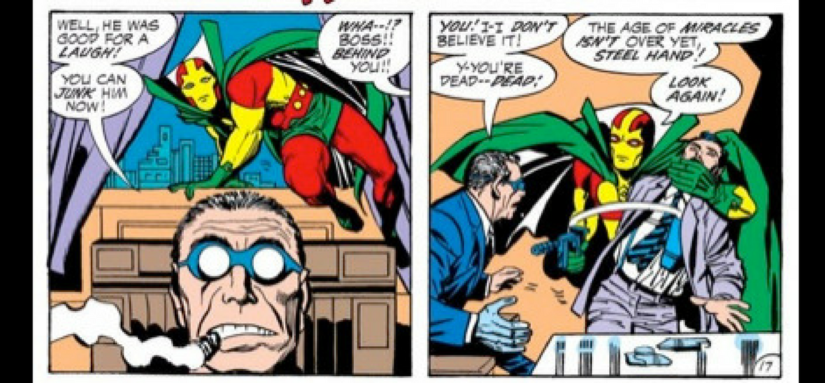Writing for Blastoff has been as much of a comics history lesson for me as it has been a writing project. I’ve known Blastoff Comics owner Scott Tipton for as long as I’ve been writing comics. Well, longer, actually. I added him on Facebook – being sure to avoid adding the congressman of the same name; a rookie mistake – and began chatting about comics. We talked mostly about the comics he was writing and the related titles, because those were the ones that sparked my interest in the medium that I had left behind years earlier in favor of my obsession with prose. It was talking about the Angel comics with Scott that started all of this, because our conversations about Illyria and Spike soon led to contemporary superhero comics as I began to explore Marvel and DC’s current offerings. When I began writing for Blastoff, the idea for my coverage of classic comics was to examine their historical context from my admittedly removed perspective. While Scott’s encyclopedic knowledge of comics history is likely unrivaled, I’m learning as I go along.
I mention all of this because we’re deep into Jack Kirby month here at Blastoff Comics, and I have to let you know something before we begin… I don’t know that much about Kirby. Here’s what I do know.
- His work has influenced generations of comics creators in a way that few other bodies of work have, and will continue to do so for as long as comics are produced.
- He created or co-created an incredible number of icons that will far outlive everyone who is currently reading these words.
- I know his style when I see it.
- He’s damn good.
I’d like to know more about Kirby, though, because while I may not be a penciller, I am a comic book creator… and his DNA is so deeply embedded into comics that it’s only right to look back and see the source of this immense influence at work. So now, we begin the six-part Journey With Jack, where I will read a selection of comics, chosen by Scott, which encapsulate some of Kirby’s most interesting, dynamic, creative, and iconic work.
We begin with Mister Miracle #1.
Mister Miracle #1 is written, penciled, and edited by Jack Kirby; inked by Vince Colletta; and lettered by… well, I don’t know. It was released in 1971, and there’s no credit for those roles. This always serves to remind me how far we’ve come in recognizing the immense talent it takes to work as a colorist and letterer in comics… but I digress. Let’s talk Mister Miracle.
Story-wise, Mister Miracle is a bait and switch. It sets up the elderly escape artist Thaddeus Brown as the title character, throwing us into the middle of his story and letting us catch up. However, by the end of the issue, Thaddeus is dead and his protégé and friend Scott Free has taken on the mantle with help from Thaddeus’s assistant, Oberon. It’s a superhero tale, but it feels removed from what I’ve read of Kirby’s Marvel work – much stranger, playing less with tropes of heroism and what being a superhero does to a person, and more with high concepts and weirder ideas. We hit the ground running in Mister Miracle’s story and the pace never lets up, which makes the read both jarring and consistently surprising. Having known nothing about Mister Miracle to begin with, seeing Scott fill his mentor’s shoes so early in the series was a bold choice – because the comic very much pits Thaddeus as the main character until the very moment he dies. It would be as if, two-thirds into Spider-Man’s first adventure, Peter Parker gets capped and a relatively minor character decides to fill his shoes. It’s a creative way to begin the story of this left-of-center hero, setting it apart from every classic superhero origin story I’ve read.
On the art front, this issue, besides being gorgeously drawn, goes a long way to show the lasting effect that Kirby’s work – particularly in pacing – has had on comics. So many comics around this time, and even up to a decade and a half later, were densely drawn and written, packing what would amount to pages worth of information into a single panel. In the mid- and late-2000s, comics shifted harshly in the other direction and became obsessed with decompression, stretching simple moments out over the course of panels and pages to the detriment of the story. Now, it’s easy to tell the difference between well-paced, cinematic pages and overly decompressed stories diluted in order to fill a trade paperback. Kirby was a master of this technique even back then, using cinematic pacing while also being sure to utilize every panel to convey information and movement to the reader. This sequence stood out in particular:
It’s easy to say that this kind of sequence is common these days, but putting this in context of the time in which it was created, it’s clear that Kirby was pushing at the boundaries of comics. It makes me think of something that Jay-Z said in an interview about Kanye West: “What tends to happen is someone has to experiment and do it first, and then artists will sit back and watch it, and be like ‘Okay, I like this, I don’t like that, I like this part’ and they’ll perfect the methods… it all pushes the genre forward. Which is good, and that’s what he does, he’s like the lightning rod for the culture.”
Progress happens over time. Well, sometimes. Sometimes, Jack Kirby figures out the way to marry cinematic artwork with dense storytelling in a smooth and effective way back in the early 70s, while it takes most else a good handful of decades later to catch up.
NEXT TIME: We meet Kamandi, the last boy on Earth.






Comments are closed.